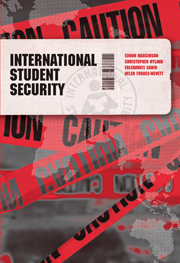Book contents
- Frontmatter
- Contents
- List of figures
- List of tables
- About the authors
- Preface
- PART 1 Students in the global market
- PART 2 Security in the formal and public domain
- 5 Finances
- 6 Work
- 7 Housing
- 8 Health
- 9 Safety of the person
- 10 The immigration department
- PART 3 Security in the informal and private domain
- PART 4 Protection and empowerment
- References
- Index
9 - Safety of the person
Published online by Cambridge University Press: 05 August 2012
- Frontmatter
- Contents
- List of figures
- List of tables
- About the authors
- Preface
- PART 1 Students in the global market
- PART 2 Security in the formal and public domain
- 5 Finances
- 6 Work
- 7 Housing
- 8 Health
- 9 Safety of the person
- 10 The immigration department
- PART 3 Security in the informal and private domain
- PART 4 Protection and empowerment
- References
- Index
Summary
So if the prime motive is education, go to the US. If the motive is immigration, come to Australia. And the quality of life is as good as anywhere else. And it's safer than any other country.
~ male, 23 years, computing, IndiaINTRODUCTION: THE LOGIC OF DENIAL
In 2006, just after the main body of interviews for this study were conducted, Australian Education International conducted a survey of international students in Australia, including 3585 who were enrolled in the final year of programs in higher education. Respondents were asked to order the importance of factors affecting their decision to study in Australia. Among higher education students the most important reason for coming to Australia was that it was an English-speaking country, which was nominated by 90 per cent. The second most important reason was that Australia was ‘safe and secure’, or ‘a safe place to live’, which were nominated by 87 per cent. These two reasons ranked ahead of other considerations, such as the quality of education and the opportunity to experience a new culture and lifestyle. Among students from Indonesia (94 per cent), India (93 per cent) and Singapore and Malaysia (91 per cent), safety and security were the most important reasons for choosing Australia. It ranked highly among students from all other national groupings, including those from China and Hong Kong China (90 per cent).
- Type
- Chapter
- Information
- International Student Security , pp. 204 - 240Publisher: Cambridge University PressPrint publication year: 2010

